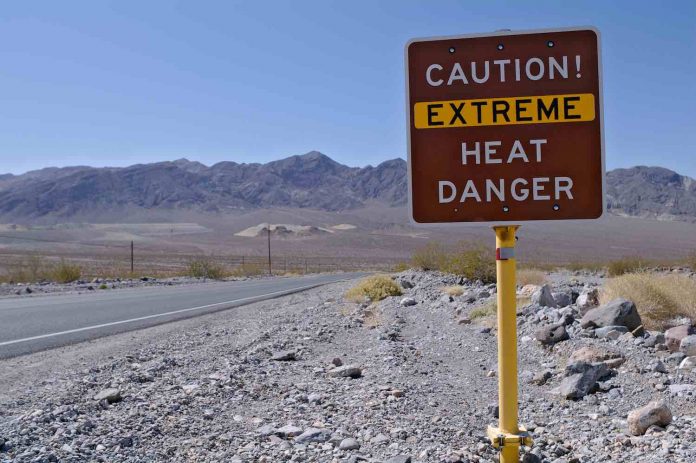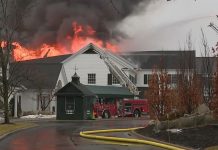*On July 10, 1913, Death Valley, California reached an amazing 134 degrees…the hottest temperature ever reliably recorded in a year with many remarkable weather events*
Overview
The high temperature in Death Valley, California on Friday will come close to 120°F, but this is still well short of the all-time record there that occurred way back in 1913. On July 10th, 1913, the weather observer at Greenland Ranch in Death Valley recorded a high temperature of 134°F. One hundred and seven years later, this is still the highest air temperature ever reliably recorded on Earth. In addition to this all-time and worldwide high temperature record, the year of 1913 produced numerous other extreme weather events.
Asphalt roadway near the salt flats of Death Valley National Park in California
Why so hot in Death Valley?
Death Valley National Park is the largest national park in the continental US and is located in the Mojave Desert of southeast California. It contains a vast range of elevations and landscapes and is known for being a land of extremes including its climate. In fact, the depth and shape of Death Valley contribute greatly to its extreme heat. Specifically, the extreme heat is due to a combination of several factors including the elevation below sea level (282 feet), the lack of vegetation; especially, on the lowest part of the valley floor which allows sunlight to directly heat the desert surface, the narrow width of the valley and its north-south orientation which traps air in the valley allowing it to be recycled back down to the valley floor, radiation of heat from the rocky surfaces of the mountains that surround the valley, and the low humidity as dry air heats at a much quicker rate than moist air and greatly inhibits the formation of clouds. Temperatures in Death Valley normally reach or exceed 100°F from mid-May until early October.
Extreme weather of 1913
The intense heat of July 1913 in California was not the only extreme heat measured that year in the US. There was a widespread heat wave in June of that same year across the eastern half of the nation which resulted in many readings above 100°F. In fact, NOAA’s official temperature records still cite June 16, 1913 as the hottest ever on a nationwide basis for that particular date. In addition to the excessive heat seen across the US that year, there are newspaper articles from that same time period suggesting high heat may have taken place in others part of the world. One such article (excerpt shown above) written on March 30, 1913 reported that “recent observations seem to show that glaciers are gradually disappearing all over the world”.
In addition to the extreme heat, 1913 featured other severe and deadly weather events across the US. During March, one of the worst floods ever in this nation took place after major rivers in the central and eastern US flooded from runoff and several days of heavy rain. This flood now referred to as the “Great Flood of 1913” remains one of the worst natural disasters ever for Ohio with places like Dayton in the southwestern part of the state submerged underwater for several days. Later that same very eventful year, one of the worst storms ever for the Great Lakes region took place and it is now referred to in multiple ways including “White Hurricane”, “Freshwater Fury” or simply “The Great Lakes Storm of 1913”. This powerful storm was a blizzard with hurricane-force winds that devastated the Great Lakes Basin and the province of Ontario in Canada from November 7 through November 10, 1913.
During July 1913, Death Valley, California endured an intense stretch of hot weather from the 5th through the 14th when the high temperature reached 125°F or higher each and every day. In fact, this 10-day stretch still ranks as the hottest stretch ever recorded in Death Valley. The hottest days in this time period occurred from the 9th through the 13th when the high temperature reached at least 129°F with the hottest being on July 10th when the record-breaking 134°F was measured.
Weather station reliability at Greenland Ranch
In terms of the reliability of the Greenland Ranch weather station at Death Valley, California, there should be little question in that regard. The US Weather Bureau (now known as the US National Weather Service) actually established this weather station in 1911 in cooperation with the company that operated the ranch. In their own words, the US Weather Bureau “carefully tested maximum and minimum thermometers” and stated that “the instrument shelter at this station is the same as those used at several thousand other weather stations maintained by the Weather Bureau throughout the United States”. The US Weather Bureau summarized by stating “the extreme maximum temperature of 134°F recorded on July 10, 1913, is the highest natural-air temperature ever recorded on the earth’s surface by means of a tested standard thermometer exposed in a standard ventilated instrument shelter”.
Interesting twist to the record
In this particular case, we are dealing with what appears to be a reliable high temperature record that was set long ago and still stands today as the all-time record on the planet, but there is an interesting twist to the record. The Death Valley, California record of 134°F was less than a decade old when it fell to a new record. On September 13, 1922, a temperature of 136°F was recorded at El Azizia, Libya and this was indeed cited by the World Meteorological Organization (WMO) for nine decades as the world’s highest temperature ever recorded. However, on September 12th, 2012, the WMO officially re-certified the 134 degree reading of July 10th, 1913 at Death Valley, California as the all-time highest air temperature ever recorded on Earth after evidence surfaced suggesting the Libya record of 136°F was based on a reading from a bad thermometer that was placed in the wrong place (near asphalt) and read by an untrained observer.
Cooperative observer form for July 1913 from Greenland Ranch in Death Valley, California. The high of 134°F recorded on July 10 is circled in red.
In fact, there are many risks when comparing high temperature records set in today’s world to those set decades ago. Many of today’s “official” reporting weather stations have had significant growth in development (housing, roads, etc.) in their immediate surrounding region with materials like asphalt and concrete that are known to have an overall warming effect on temperatures. This “urban heat island (UHI)” effect has become an increasingly important problem to deal with in the analysis of long-term temperature trends and the evaluation of modern day high temperature records. In the Southwest US, for example, where populations have doubled or tripled in the past 50 years near official reporting weather stations (e.g., Las Vegas, NV, Phoenix, AZ), the UHI effect has become important enough that record high temperature records of today are questioned in some locations. Even the inhospitable region of Death Valley has had some development in the area surrounding today’s weather station at Furnace Creek with asphalt roads now leading to a nearby visitor’s center – all of which makes this long-surviving record of 134°F set in 1913 at Greenland Ranch very impressive indeed.
One final note of interest, the coldest temperature ever recorded at Death Valley occurred in, yes, the same year of 1913. On January 8th, 1913, the temperature dropped to 15°F at Furnace Creek which is the lowest ever recorded in Death Valley.













